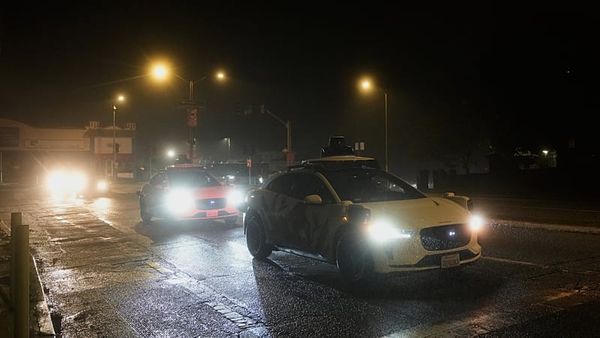
Luxury automakers are in a strange middle ground with EV adoption right now. They need to bring electric versions of their most popular models to market, while also keeping internal-combustion and hybrid variants alive and fresh for longer than expected, often on different platforms.
Porsche is already in that position with the Macan. BMW will be there with the iX3 and X3 later this year. Now, Mercedes-Benz is joining the fray with an electric GLC crossover due out in Spring 2026. Development is largely complete, and the Stuttgart-based automaker invited us to sample a camouflaged prototype at its massive testing facility. We’re still a ways off from production, as evidenced by a draped-off interior and teams of engineers scurrying around, but the early signs are promising.
2026 Mercedes-Benz GLC EV: What Is It?
The gas-powered GLC crossover was Mercedes’ best-selling model last year, both worldwide and in the U.S. It makes sense that the brand’s second-generation EV plan includes an electric equivalent that, like the new CLA, keeps the name customers already know. Farewell, EQ nomenclature—I can’t say we’ll miss you.
Mercedes did take a first stab at a small electric crossover with its first EQ model, the EQC in 2019. The EQC shared a platform with the internal-combustion GLC, and there were plans for a U.S. launch. That never happened, and Mercedes brought us the larger EQE SUV in 2022 instead.



The GLC EV rides on an entirely new 800-volt EV platform that Mercedes tells us isn’t related to either the combustion GLC or the electric CLA. It’s a scalable architecture, so we’ll likely see it in future electric Mercedes sedans and crossovers. Immediately, I noticed a lower roofline at the rear and a sleeker profile overall than the standard GLC, owing to a 3.3-inch longer wheelbase. It has a tall wagon vibe in profile and from the rear three-quarter, I like it.
Despite the taper, Mercedes says the new GLC has more headroom, passenger space and cargo space than the existing GLC. While the trunk’s 19.8 cubic feet behind the rear seats falls short of the gas GLC’s 21.9, the EV also adds a frunk with 3.5 cubic feet of cargo room. That’s a big deal on its own, as previous Mercedes-EQ cars lacked frunks. They didn’t even let owners open their hoods.
2026 Mercedes-Benz GLC EV: Range and Performance
The test model featured the launch configuration, dubbed “400e.” It features a 94.5-kWh battery pack and dual electric motors—one front, one rear. The drivetrain engages both motors in low-traction and spirited driving scenarios, but the front one can be decoupled for efficiency when it’s not needed. Mercedes says later models will be offered with just a single electric motor in the rear. The powertrain provides 403 miles (650 km) of estimated range on the European WLTP cycle—figure around 320 miles (515 km) in EPA testing, give or take. The battery uses nickel manganese cobalt (NMC) cells, though we’re told a lithium-iron-phosphate pack will be available in other markets. LFP packs are cheaper but offer less range for their size, generally.

On an 800-volt DC fast charger, Mercedes says the GLC has a peak charging power of 320 kW and can add 161 miles (260 km) of range in 10 minutes. It confirmed that the GLC will ship to the U.S. with a NACS port from day one, and that it will be capable of DC fast charging at Tesla Superchargers. Because Superchargers are 400 volts, however, the GLC will likely charge slower here than it does in Europe. Mercedes didn’t provide a peak charging speed on 400-volt architecture. The Tesla Model Y can charge at 250 kW on a V4 Supercharger, and the Porsche Macan EV maxes out at 270 kW.
The GLC 400e puts out 483 horsepower (360 kW). That slots above the electric Macan 4 and just below the 4S, though it’s trounced by the 630-hp Macan Turbo. I’ll have to hope for an eventual AMG model to settle that matchup. Interestingly, Mercedes says the GLC uses a two-speed transmission like Porsche’s Taycan (the Macan uses a single-speed). Mercedes says this makes the GLC more efficient at high speeds. It wouldn’t tell us whether the transmission was developed in-house or by a supplier.
2026 Mercedes-Benz GLC EV: Driving Impressions
I had a roughly 30-minute drive in a prototype around Mercedes’ sprawling Immendingen test facility to get to know the GLC EV. That’s a short time in a controlled environment and not grounds for a conclusive opinion. That said, I found the car agile, quick and easy to drive.


The prototype took off with little drama, providing that brisk, satisfying EV shove while avoiding touchy throttle tip-in or jerkiness. Accelerating out of uphill hairpins, the GLC just hooked up and went without a hint of wheelspin. There are three regenerative braking modes: One that allows for one-pedal driving and will bring the car to a full stop, one that allows it to coast and a default position somewhere in the middle. I’d personally use the heavy-regen mode nearly all the time, as I found it intuitive and easy to modulate. I didn’t have the chance to switch the GLC fully off on our prescribed loop, so I’m not sure whether a mode preference can be saved or if it resets every time you start the car—a pain point with current Mercedes EVs.
The GLC EV’s maneuverability is aided by the rear wheels, which can turn up to four-and-a-half degrees. That gives it a turning radius of just 36 feet (11 meters), just edging out the Macan’s 11.1 meters with rear-steer. The system felt quite natural in my brief drive, making the GLC very maneuverable on tight switchbacks and in parking lots while remaining stable at speed.

The best-damped cars breathe with the road, meaning they feel connected and controlled but not harsh or bouncy. After driving the GLC on Mercedes’ (intentionally) pockmarked “country road,” I’d put it in that category. It uses a dual-mode air suspension with Comfort and Sport settings, and the latter soaked up bumps and heaves with composure. Between the smooth ride and eager handling, the GLC didn’t feel ponderous at all.
GLC Chief Engineer Stephanie Salewyn told me one of her biggest development goals was to create a car that was rejuvenating rather than fatiguing to drive. I didn’t spend enough time in it to know whether it lives up to that promise, but I did find it quite comfortable.
2026 Mercedes-Benz GLC EV: Early Thoughts
We don’t know what the GLC EV will cost, what tech it will have, or even how it looks without the camo. But it’s clear to me that Mercedes is taking the assignment seriously, as it well should.
Gallery: 2026 Mercedes-Benz GLC EV Camo Drive







Bringing a new EV to market is tough even in the best of times, and these are far from the best of times. The new GLC will be built at Mercedes’ plant in Bremen, Germany, meaning it’ll be subject to 25% import tariff in the U.S. as of writing. That’ll make it hard for Mercedes to compete on price. Also, I’d wager this car’s success will rely heavily on software and user interfaces—things I didn’t get to sample at all on this limited preview, and areas where Mercedes has struggled recently.
Customers need more good EV options in existing segments, and I’m glad Mercedes is finally taking the fight to Porsche, BMW and Tesla in its most important one. However, its NACS charging performance, pricing, and tech are firmly in the “wait and see” category. Let’s see how it plays out.







